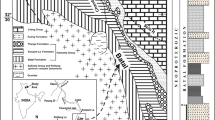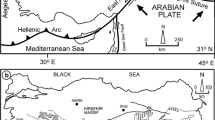Abstract
In this paper, we consider the lithogeochemical characteristics of pelitic rocks from the molasses (Late Permian) of the Southern Ural segment of the Uralian foredeep. The examination of mudstones showed that they contain high and variable amounts of secondary carbonate minerals and, consequently, high and variable CO2, which complicates the use of traditional lithochemical diagrams for their classification and genetic reconstructions. On the other hand, the lithogeochemical characteristics of the pelites (as well as psammites) provided evidence on the compositions of provenances in paleocatchments. High Cr and Ni contents indicate the presence of ultrabasic rocks in the provenances, and the distribution of Cr/Ni values suggests insignificant chemical homogenization of aluminosilicate fine-grained clastic materials and, consequently, short transport distances. The dominant first-cycle nature of the clay rocks is indicated by the relations of major oxides and various lithochemical indexes. The heterogeneous and complex composition of the end-Permian provenance is supported by the covariation diagrams of indicator trace element ratios.
Similar content being viewed by others
References
G. A. Mizens, “On the stages of formation of the Uralian Foredeep,” Geotectonics 31(5), 374–385 (1997).
G. A. Mizens, Upper Paleozoic Flysch of the Western Urals (UrO RAN, Yekaterinburg, 1997) [in Russian].
G. A. Mizens and A. V. Maslov, “Sandstones of the molasse formation of the Southern Ural segment of the Cis-Ural foredeep: specifics of mineral-petrographic and chemical composition,” Lithol. Miner. Resour. (in press).
S. R. Taylor and S. M. McLennan, Continental Crust: Its Composition and Evolution (Blackwell, 1985; Mir, Moscow, 1988).
H. R. Rollinson, Using Geochemical Data: Evaluation, Presentation, Interpretation (London Group UK Ltd, Essex, 1994).
Ya. E. Yudovich and M. P. Ketris, Principles of Lithochemistry (Nauka, St. Petersburg, 2000) [in Russian].
Interpretation of Geochemical Data, Ed. by E. V. Sklyarov (Intermet Inzhiniring, Moscow, 2001) [in Russian].
Geochemistry of Sediments and Sedimentary Rocks: Evolutionary Considerations to Mineral Deposit-Forming Environments, Ed. by D. R. Lentz (Geol. Ass Canada, 2003). GeoText 4.
A. V. Maslov, Sedimentary Rocks: Methods of Study and Interpretation of Data (Izd-vo UGGU, Yekaterinburg, 2005) [in Russian].
Stratigraphic Schemes of the Urals (Precambrian, Paleozoic) (Roskomnedra, IGG UrO RAN, Yekaterinburg, 1993) [in Russian].
V. P. Tverdokhlebov, “Piedmont fans and aeolian deposits as indicators of aridity at the eastern European part of Russia at the beginning of the Triassic,” Izv. Vyssh. Uchebn. Zaved., Geol. Razved., No. 1, 53–57 (2001).
V. P. Tverdokhlebov, “Features of accumulation of alluvial and deltaic deposits under arid climatic conditions,” Izv. Vyssh. Uchebn. Zaved., Geol. Razved., No. 2, 146–148 (2001).
Geological Map of the Urals. Scale 1: 500000, Ed. by I. D. Sobolev (UTGU, Sverdlovsk, 1979) [in Russian].
A. V. Maslov, M. T. Krupenin, and D. V. Kiseleva, “Lithogeochemistry of the fine-grained siliciclastic rocks of the Vendian Serebryanka Group of the Central Urals,” Geochem. Int. 49(10), 974–1001 (2011).
K. C. Condie, “Chemical composition and evolution of the upper continental crust: contrasting results from surface samples and shales,” Chem. Geol. 104, 1–37 (1993).
A. A. Migdisov, Yu. A. Balashov, I. V. Sharkov, O. G. Sherstennikov, and A. B. Ronov, “Abundance of the rare-earth elements in major lithological rock types of sedimentary cover of the Russian Platform,” Geokhimiya, No. 6, 789–803 (1994).
M. M. Herron, “Geochemical classification of terrigenous sands and shales from core or log data,” J. Sediment. Petrol. 58, 820–829 (1988).
Ya. E. Yudovich, M. P. Ketris, and E. Z. Gareev, “Nature of anomalous accumulations of potassium in clay rocks,” Geokhimiya, No. 5, 689–700 (1991).
V. K. Golovenok, Precambrian Aluminous Formations (Nedra, Leningrad, 1977) [in Russian].
A. B. Ronov and A. A. Migdisov, “Quantitative regularities in structure and composition of sedimentary sequences of the East European Platform and Russian Plate and their setting among ancient platforms of the World,” Lithol. Miner. Resour. 31(5), 401–424 (1996).
B. D. Roser and R. J. Korsch, “Determination of tectonic setting of sandstone mudstone suites using SiO2 content and K2O/Na2O ratio,” J. Geol. 94, 635–650 (1986).
J. I. Garver, P. R. Royce, and T. A. Smick, “Chromium and nickel in shale of the Taconic Foreland: a case study for the provenance of fine-grained sediments with an ultramafic source,” J. Sediment. Res. 66, 100–106 (1996).
R. Cox and D. Lowe, “A conceptual review of regionalscale controls on the composition of clastic sediment and the co-evolution of continental blocks and their sedimentary cover,” J. Sediment. Res. A65, 1–12 (1995).
R. Cox, D. R. Lowe, and R. L. Cullers, “The influence of sediment recycling and basement composition on evolution of mudrock chemistry in the southwestern United States,” Geochim. Cosmochim. Acta 59, 2919–2940 (1995).
A. V. Maslov, G. A. Mizens, V. N. Podkovyrov, E. Z. Gareev, A. A. Sorokin, Yu. N. Smirnova, and T. M. Sokur, “Synorogenic psammites: main lithochemical features,” Lithol. Miner. Resour. 51(1), 44–64 (2013).
A. V. Maslov and V. N. Podkovyrov, “Late Vendian unfolded molasse in the northeastern, eastern, and southwestern peripheries of the East European Platform: distinctive lithogeochemical features,” Geochem. Int. 51(1), 44–64 (2013).
Author information
Authors and Affiliations
Corresponding author
Additional information
Original Russian Text © G.A. Mizens, A.V. Maslov, 2014, published in Geokhimiya, 2014, No. 11, pp. 1025–1042.
Rights and permissions
About this article
Cite this article
Mizens, G.A., Maslov, A.V. Pelitic rocks from the molasse formation of the Southern Ural segment of the Uralian foredeep: Lithogeochemistry, provenance composition, and paleotectonic reconstructions. Geochem. Int. 52, 962–978 (2014). https://doi.org/10.1134/S0016702914110056
Received:
Accepted:
Published:
Issue Date:
DOI: https://doi.org/10.1134/S0016702914110056




